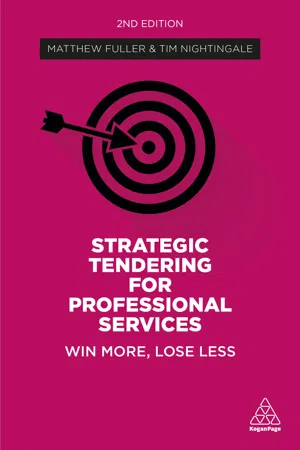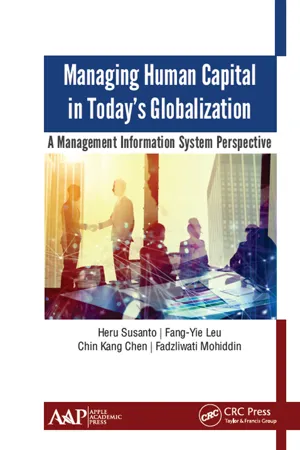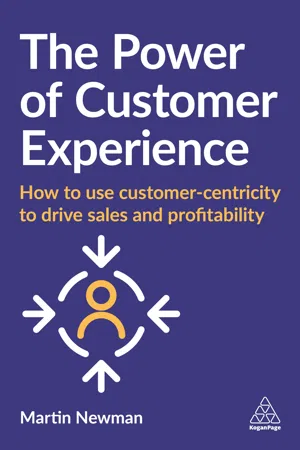Diversity and Inclusion
Diversity and inclusion refer to the practice of creating a work environment that embraces and values individual differences. This includes differences in race, ethnicity, gender, sexual orientation, age, and more. In a diverse and inclusive workplace, all employees feel respected, supported, and empowered to contribute their unique perspectives and talents.
5 Key excerpts on "Diversity and Inclusion"
- eBook - ePub
Strategic Tendering for Professional Services
Win More, Lose Less
- Matthew Fuller, Tim Nightingale(Authors)
- 2022(Publication Date)
- Kogan Page(Publisher)
...It’s not a static experience and can change depending on the current experience, eg the line manager or the engagement team’s perceived inclusiveness. Research shows a strong link between belonging, employee wellbeing, productivity and commercial outcomes. 1 One way of considering the difference between these terms is that diversity is about facts, inclusion is about choice and belonging is about emotion. More colloquially, diversity can be described as being invited to the party, inclusion as being asked to dance and belonging as dancing like no one is watching! Why is D&I a priority for organizations now? As another respondent to the survey says: ‘I know many companies take an approach that firms need to meet minimum thresholds to be able to work with them.’ So where has this priority come from? In large part, organizations started to pay attention to D&I when legislation forced their hand. This was the case in the US, the UK, across much of Europe and parts of the rest of the world. The legislative focus in each country is different, although all domains focus on gender equality in some form and an increasing number have equality protections for people with disabilities, LGBT+, and, in some places, religion/faith and ethnicity. These vary significantly. For example, the protections in France do not allow companies to collect certain categories of data, including race/ethnicity. In Northern Ireland there is a requirement to record religion. Much of this reflects the political and historical context of the country or region. Most commonly, if you are submitting a tender for a multinational organization, you may find they ask mainly about diversity in terms of gender...
- Stephen Taylor, Graham Perkins(Authors)
- 2021(Publication Date)
- CIPD - Kogan Page(Publisher)
...The presence of such issues suggests that, whilst progress has been made, it would be demonstrably fallacious to argue that further steps cannot be taken to promote equality and diversity within our organisations. It has been argued that discriminatory stereotypes and attitudes persist because of a number of deep-seated psychological mechanisms, and although an exploration of these is beyond the scope of the current book, this is an area of active scholarly and practitioner research interest. Moving on from the subject of equality, we come to diversity. Many scholars and writers within this field conflate the terms ‘diversity’ and ‘inclusion’, which again adds a level of confusion to the territory. For our purposes, the CIPD (2018) suggests a straightforward definition: Diversity is about recognising difference, but not actively leveraging it to drive organisational success. It’s acknowledging the benefit of having a range of perspectives in decision-making and the workforce being representative of the organisation’s customers. Perhaps the key point of note within this definition is the idea that diversity is about the recognition of difference, but that this does not automatically extend to our organisations actively taking advantage of difference to drive improved performance. This presents somewhat of a problem with current approaches to diversity management, but helpfully a resolution is found when we consider the subject of ‘inclusion’: Inclusion is where difference is seen as a benefit, and where perspectives and differences are shared, leading to better decisions. An inclusive working environment is one in which everyone feels valued, that their contribution matters and they are able to perform to their full potential, no matter their background, identity or circumstances...
- eBook - ePub
Managing Human Capital in Today's Globalization
A Management Information System Perspective
- Heru Susanto, Fang-Yie Leu, Chin Kang Chen, Fadzliwati Mohiddin, Heru Susanto, Fang-Yie Leu, Chin Kang Chen, Fadzliwati Mohiddin(Authors)
- 2019(Publication Date)
- Apple Academic Press(Publisher)
...CHAPTER 8 WORKFORCE DIVERSITY: INFORMATION COMMUNICATION TECHNOLOGY INNOVATION AND CREATIVITY ABSTRACT Diversity classified into two dimensions: primary and secondary dimension. The primary dimension consists of visible elements, which include age, gender, and sexual orientation, whereas differentiating elements such as religion, education, income, and geographical location are part of the secondary dimension. Managing workforce diversity very challenging for most organizations. Workforce diversity is basically concerned with the similarities and differences of employees in the organization and has become an essential element for businesses or organizations to expand their business globally and strive to achieve competitive advantage. Nowadays organizations have begun to realize that diversity is as important as any positive factor that will lead to a greater outcome for the organization as well as building up the organization to be a stronger competitive enterprise, globally. Organization must put a great effort on developing a better strategic plan of managing the workforce diversity as there is rapid growing of diversity in which resulting an increase in women and people with disabilities entering the work nature. 8.1 INTRODUCTION Diversity can be defined as understanding, recognizing, and accepting individual similarities and differences between an individual and a group of people. It can be classified into two dimensions: primary and secondary dimension. The primary dimension consists of visible elements, which include age, gender, and sexual orientation, whereas differentiating elements such as religion, education, income, and geographical location are part of the secondary dimension. According to Ashton (2010), these elements are not noticeable in the first encounter until occurrence of some interaction that involves both individuals. Managing workforce diversity in the workplace can be very challenging for most organizations...
- eBook - ePub
Managing Diversity and Inclusion
An International Perspective
- Jawad Syed, Mustafa Ozbilgin(Authors)
- 2019(Publication Date)
- SAGE Publications Ltd(Publisher)
...Technology and experience have provided employees with the ability to integrate work and life without having to commute or relocate (Future of Work Institute, 2012). WLB, Diversity and Inclusion Workplace diversity means diversity on the part of employees in terms of gender, age, nationality or ethnicity, or a variety of life experiences and lifestyles. In the area of paid work, workplace diversity helps to raise tolerance and eliminate barriers based on discrimination, prejudice and a failure to include disadvantaged individuals or groups in the labour market (Formankova and Marikova, 2015). Organisations are coming to the reality that work–life balance is no longer solely an issue for employees alone. As the world is progressing further into the 21st century, workers and ways of working are changing. There are several generations operating together in the workplace, and a tremendous variety of professional expectations, values, goals and needs. People want to work, but more and more need work to work better in their lives. For some, it might be a question of flexibility to care for family, for others, a question of personal fulfilment and being present both at work and at home (Ferreira, 2018). Regardless, people are expressing the need for an improved sense of work–life balance. It has become central to maintaining a diverse and inclusive workplace, and as companies grapple with increased talent and marketplace competition, work–life balance has become a pivotal issue for higher engagement, increased productivity, greater innovation and employee retention. Therefore, full engagement of a diverse, inclusive workforce is the competitive advantage of the present time (Donovan, 2016). Kossek (2016) notes that an increasing number of employees hold diverse identities, with work–life situations motivating them to need and want to blend work and life in different ways to manage social identities...
- eBook - ePub
The Power of Customer Experience
How to Use Customer-centricity to Drive Sales and Profitability
- Martin Newman(Author)
- 2021(Publication Date)
- Kogan Page(Publisher)
...09 Diversity and Inclusion On the outside and the inside WHAT YOU WILL LEARN IN THIS CHAPTER There is a broad range of people and requirements that fall within diversity. There are obvious benefits of being a diverse organization. Brands that have embraced Diversity and Inclusion are more customer-centric and ultimately more successful. There is a risk of thinking of diversity on its own. It has the potential to cause controversy, particularly if it’s seen as a box-ticking exercise rather than something that changes the business fundamentally and makes it a better place to work and a brand that connects more effectively with a broader range of customers. To be effective, the approach must be one of both Diversity and Inclusion. It is inclusion that leads to genuine participation. The diversity and inclusivity of the business should be something that’s a cause for celebration and a core part of the culture and DNA of the brand. The broad range of requirements that fall within diversity Figure 9.1 Core areas of diversity Diversity as a term is often interpreted too narrowly. Many perceive it to be only about gender or ethnicity. While those are very much part of the requirements for a diverse organization, it is much broader than that. It is too often approached like many other industry buzzwords, such as social responsibility, with a focus on ticking a box, proving to shareholders that it’s an ‘issue’ that has been addressed. The requirement to be a diverse business cannot be met by quotas. Nor can it be achieved by adding a few lines to the annual report. To be a truly diverse business, you have to start with your team. A diverse workforce should be representative of society in all areas, including gender expression, age, ethnicity, religion, disability, hidden disabilities, sexuality and demographics (Figure 9.1). Of course, all of this also applies to customers and how it affects their experience...




